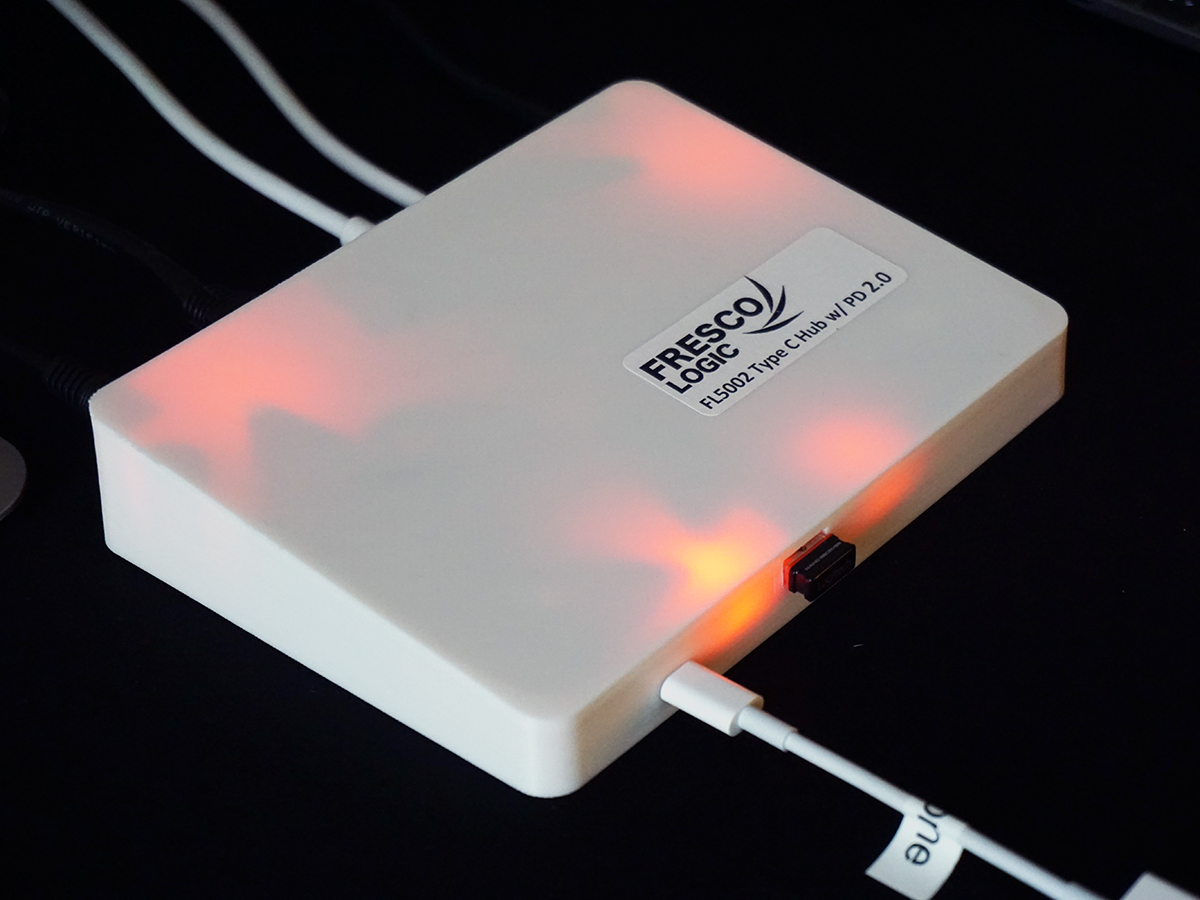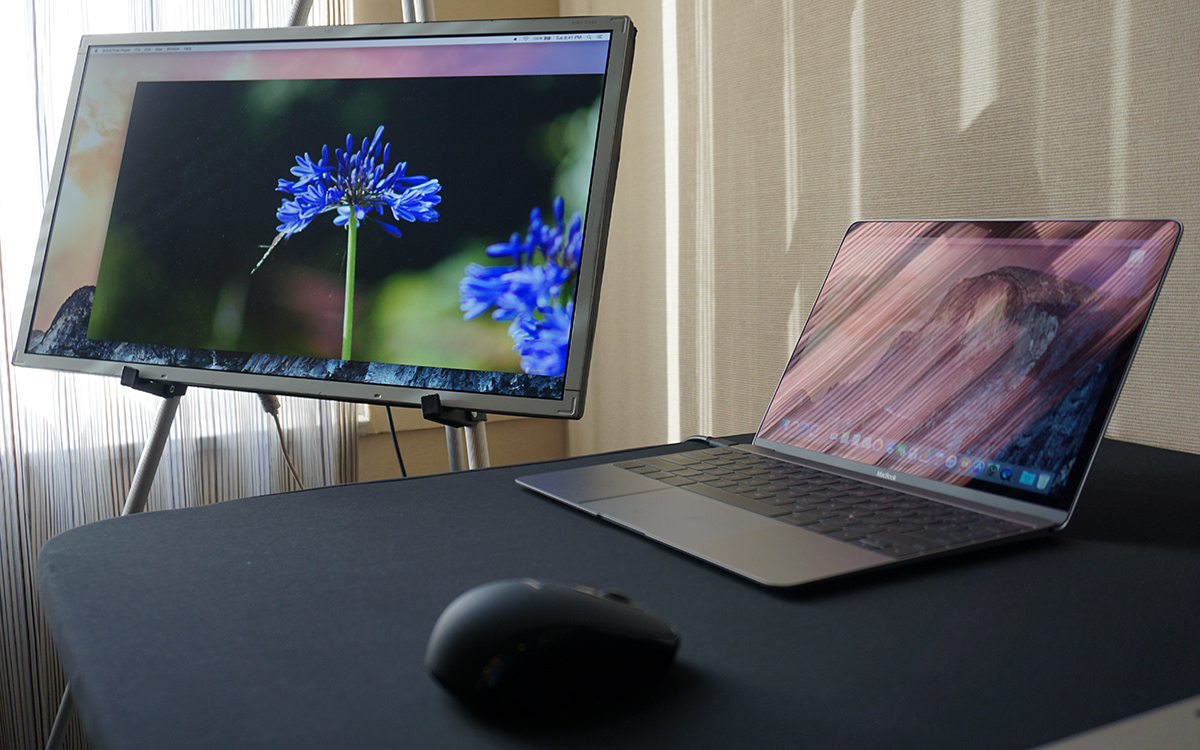More USB Type-C Demos, Still Few Actual Products
Our detailed primer on all the nomenclature and branding around USB Type-C, USB 3.1 (both SuperSpeed and SuperSpeed 10 Gbps), USB Power Delivery and Alternate Modes perhaps raised more questions than it answered, but there is most certainly a future wherein these USB technologies provide compelling uses for average users the world over.
The USB Implementers Forum (USB-IF) showed us several live demos illustrating what USB Type-C can provide in real-world circumstances.
A MacBook And A Chromebook Pixel, Sharing A Desk
There aren't very many laptops on the market yet with USB Type-C ports. Notable exceptions include the new MacBook and the latest iteration of the Google Chromebook Pixel, and -- surprise, surprise -- both were on display, connected to via a prototype Type-C hub from Fresco Logic to a monitor, mouse and keyboard.
The power for this whole demo comes from the wall outlet through the monitor, which charged whichever laptop was connected to it through the hub. The hub also connected to a wireless USB keyboard and mouse. The demonstrator showed how, with a single USB Type-C cable, you could connect the MacBook or the Chromebook Pixel to the hub; to switch from one to the other, he just disconnected the cable from one and stuck it in the other. And presto: the monitor, keyboard and mouse recognized whichever laptop was plugged in, and that device's display was up on the big monitor.
This seems obvious enough (and that's the idea), but this seamlessness requires some intelligence under the hood, particularly as it pertains to the power delivery. The two laptops run at different wattages -- we were told the MacBook needs about 25 W and the Chromebook Pixel demands approximately 45 W -- so the hub has to negotiate that on the fly, depending on which device is connected.
In real life, what this means is that you could leave your desktop setup -- monitor, keyboard, mouse and hub -- intact, and when you bring your laptop into that office, you can just plug it into the whole kit simply by attaching the USB Type-C cable to the hub. This one connection, effectively, replaces at least four cables: USB keyboard, USB mouse, HDMI (or your preferred video connection) and the laptop's power cable.
One Laptop, One Monitor, One Cable
In a slightly simpler, cleaner demo, we saw how you could use a (hacked together prototype) Texas Instruments hub, mounted on the back of a monitor, to connect a laptop and wireless mouse.
Get Tom's Hardware's best news and in-depth reviews, straight to your inbox.
Again, the power is coming from the wall socket to the monitor, and from the monitor to a laptop via a USB Type-C cable. The hub -- which is effectively invisible, as it's attached to and hidden by the monitor -- also provides connectivity to the wireless mouse. They demonstrated how the video was coming in and out between the monitor and laptop, too.
This shows a means of docking your laptop to a second monitor while simultaneously charging it, providing a connected peripheral, and keeping your desk clear of everything but your laptop and wireless mouse.
Sound Familiar?
If the above sounds familiar, it's because we saw similar demos from the USB-IF last year at IDF. Why would the group be showing us updated versions of the same kinds of demos? Because you still can't buy that handy Fresco Logic hub, and you still can't buy the behind-the-monitor hub from TI, and there are precious few tablets, laptops and smartphones you can buy that even have a USB Type-C port at all. (Even those devices that do often aren't taking advantage of some of the key features of the latest innovations in USB technology.)
There are clearly some companies making strides here -- TI and Fresco Logic, we doff our caps -- but more than a year after USB Type-C and USB 3.1 came to be, the promise of this technology has gone largely unfulfilled in the mainstream device market.
Seth Colaner is the News Director at Tom's Hardware. Follow him on Twitter @SethColaner. Follow us @tomshardware, on Facebook and on Google+.
Seth Colaner previously served as News Director at Tom's Hardware. He covered technology news, focusing on keyboards, virtual reality, and wearables.
-
InvalidError People buying into Type-C expecting full support for the 3.1 specification will remain confused and frustrated for the foreseeable future since few devices actually need to go beyond the basic 3.0 spec and many will likely end up doing USB1.x/2.0 over Type-C.Reply -
Dan414 Isn't the idea of Type C that these "hubs" are actually built into the monitor? Power goes into the monitor, and drives or mice or whatever go to the monitor and draw through it, along with the laptop?Reply -
Larry Litmanen ReplyPeople buying into Type-C expecting full support for the 3.1 specification will remain confused and frustrated for the foreseeable future since few devices actually need to go beyond the basic 3.0 spec and many will likely end up doing USB1.x/2.0 over Type-C.
It's like any technology out there, people want the latest and want to be future proof. Few years ago i got a 1080P TV when it wasn't even that widely used. I still use the same TV and every channel is 1080P now.
Many people out there are not into tech all that much and are on the budget, my GF uses a Windows XP laptop daily, so if you know you will use a product for 5+ years it is nice to be relatively future ready. -
Quixit ReplyIsn't the idea of Type C that these "hubs" are actually built into the monitor? Power goes into the monitor, and drives or mice or whatever go to the monitor and draw through it, along with the laptop?
They can be, that's the beautify of it, it's very flexible. -
agnickolov Microsoft's mobile Continuum is just around the corner with the upcoming Lumia phones the first of hopefully many true computer-in-a-phone-s fully utilizing USB 3.1.Reply -
scolaner ReplyIsn't the idea of Type C that these "hubs" are actually built into the monitor? Power goes into the monitor, and drives or mice or whatever go to the monitor and draw through it, along with the laptop?
That's one way of doing it, yes. It would also make sense to use a standalone hub.
Look, these things are all part of a technology transition. I would expect that most monitors built after X date would have this sort of "hub" built right in. But many of us will be using older monitors for years, and so we'd need a standalone (or monitor rear-mounted hub).
I can see pros and cons of various ways of doing this. But, as I said in the piece, we still can't buy...anything, really.




